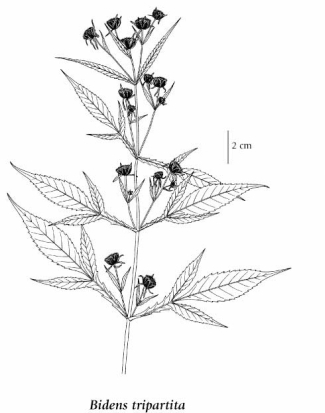three-parted beggarticks (threelobe beggarticks)
Asteraceae (Aster family)
Introduction to Vascular Plants
Species Information
General:
Annual herb from a fibrous root; stems erect, simple or branched, 20-100 cm tall.
Leaves:
Basal leaves lacking; stem leaves simple, or lowermost mostly lobed at the base, deeply incised or 3-lobed, saw-toothed, up to 20 cm long; stalks short, wing-margined.
Flowers:
Heads usually discoid; involucres 1-3 cm tall; involucral bracts linear, spreading, outer ones 1-3 cm long, inner ones 7-8 mm long; ray flowers usually lacking; disk flowers about 3 mm long.
Fruits:
Achenes wedge-shaped, outer ones 3.5-4 mm long, 2-3 angled, inner ones 5-8 mm long, 4-angled; barbs of the angles ascending below, reflexed above; pappus awns usually 4, 1-3.6 mm long.
Notes:
Bidens connata Muhl. ex Willd., native to E North America, has been collected in a cranberry bog in Richmond. It is closely related to B. tripartita.
Illustration

If more than one illustration is available for a species (e.g., separate illustrations were provided for two subspecies) then links to the separate images will be provided below. Note that individual subspecies or varietal illustrations are not always available.
Illustration Source: The Illustrated Flora of British Columbia
USDA Species Characteristics
Flower Colour:
Yellow
Blooming Period:
Late Summer
Fruit/Seed characteristics:
Colour: Brown
Present over the Fall
Source: The USDA
Habitat and Range
Moist to wet ditches and ponds in the lowland zone; rare in SW BC, known only from the lower Fraser Valley; introduced from E. North America and Europe.Status Information
| Origin Status | Provincial Status | BC List (Red Blue List) | COSEWIC |
|---|---|---|---|
| Exotic | SNA (2019) | Exotic | Not Listed |
BC Ministry of Environment: BC Species and Ecosystems Explorer.
Synonyms
Synonyms and Alternate Names:
Bidens acuta (Wieg.) Britt.
Bidens comosa (A. Gray) Wiegand
Taxonomic Keys
The following three Bidens species are most easily confused.
1. Ray florets absent ........................ Bidens tripartita 1. Ray florets present, yellow ............................. 2 2. Summit of mature achenes convex and cartilaginous, heads nodding, fruiting heads on pressed specimens spherical, leaves strap-like and never deeply three-lobed ........................... Bidens cernua 2. Summit of mature achenes flat or concave, not cartilaginous, heads erect, fruiting heads on pressed specimens hemispherical, leaves not strap-like, often three-lobed.......................................... Bidens amplissima Source: Modifed from Ganders, Fred, Rose Klinkenberg and Brian Klinkenberg. 2002. British Columbia loses an endemic species: Bidens amplissima (Asteraceae) also occurs in Washington State. Botanical Electronic News 293. |